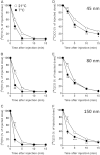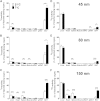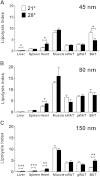Brown adipose tissue takes up plasma triglycerides mostly after lipolysis
- PMID: 25351615
- PMCID: PMC4274071
- DOI: 10.1194/jlr.M052746
Brown adipose tissue takes up plasma triglycerides mostly after lipolysis
Abstract
Brown adipose tissue (BAT) produces heat by burning TGs that are stored within intracellular lipid droplets and need to be replenished by the uptake of TG-derived FA from plasma. It is currently unclear whether BAT takes up FA via uptake of TG-rich lipoproteins (TRLs), after lipolysis-mediated liberation of FA, or via a combination of both. Therefore, we generated glycerol tri[(3)H]oleate and [(14)C]cholesteryl oleate double-labeled TRL-mimicking particles with an average diameter of 45, 80, and 150 nm (representing small VLDL to chylomicrons) and injected these intravenously into male C57Bl/6J mice. At room temperature (21°C), the uptake of (3)H-activity by BAT, expressed per gram of tissue, was much higher than the uptake of (14)C-activity, irrespective of particle size, indicating lipolysis-mediated uptake of TG-derived FA rather than whole particle uptake. Cold exposure (7°C) increased the uptake of FA derived from the differently sized particles by BAT, while retaining the selectivity for uptake of FA over cholesteryl ester (CE). At thermoneutrality (28°C), total FA uptake by BAT was attenuated, but the specificity of uptake of FA over CE was again largely retained. Altogether, we conclude that, in our model, BAT takes up plasma TG preferentially by means of lipolysis-mediated uptake of FA.
Keywords: cholesterol; chylomicrons; fatty acid metabolism; lipids; lipoprotein lipase; lipoproteins/metabolism.
Copyright © 2015 by the American Society for Biochemistry and Molecular Biology, Inc.
Figures







References
-
- van Marken Lichtenbelt W. D., Schrauwen P. 2011. Implications of nonshivering thermogenesis for energy balance regulation in humans. Am. J. Physiol. Regul. Integr. Comp. Physiol. 301: R285–R296. - PubMed
-
- Cannon B., Nedergaard J. 2004. Brown adipose tissue: function and physiological significance. Physiol. Rev. 84: 277–359. - PubMed
-
- Zimmermann R., Strauss J. G., Haemmerle G., Schoiswohl G., Birner-Gruenberger R., Riederer M., Lass A., Neuberger G., Eisenhaber F., Hermetter A., et al. 2004. Fat mobilization in adipose tissue is promoted by adipose triglyceride lipase. Science. 306: 1383–1386. - PubMed
-
- Bartelt A., Bruns O. T., Reimer R., Hohenberg H., Ittrich H., Peldschus K., Kaul M. G., Tromsdorf U. I., Weller H., Waurisch C., et al. 2011. Brown adipose tissue activity controls triglyceride clearance. Nat. Med. 17: 200–205. - PubMed
Publication types
MeSH terms
Substances
LinkOut - more resources
Full Text Sources
Miscellaneous

